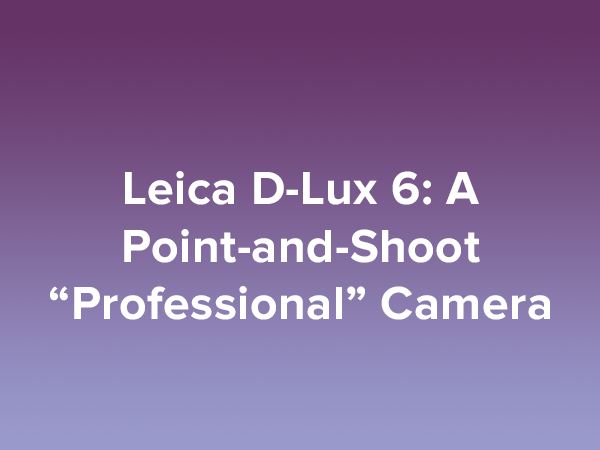Leica D-Lux 6: A Point-and-shoot “Professional” Camera
If point-and-shoot cameras were classified as “entry,” “advanced amateur” and “professional” the way DSLR’s are classified, the Leica D-Lux 6 is the top of the line “pro” model point-and-shoot.

Of course point-and-shoot cameras are all easy to use mass market cameras designed for people who just want to take a picture with better quality then their IPhone. However, the D-Lux model, Leica’s only consumer camera model, is the carry around camera of choice for many professionals.
Brian Peterson, for example, keeps a Leica D-Lux with him at all times. Peterson says it is more than just the Leica red dot on the camera that drew him to it. It is the power of the D-Lux’s Macro capability that makes it a good choice for a small camera to carry around.
The Leica brand is exclusive and expensive. All of their lenses are handmade in Germany with precision and they are known as the sharpest optics in photography. The Leica D-Lux 6 has an approximate $700 price, which is double or triple of most point and shoot cameras. There is little question that the less expensive Panasonic Lumix camera is similar to the Leica D-Lux and even made by Leica for Panasonic.
So, why buy the expensive Leica D-Lux 6 except for the prestige of shooting with the same brand as the great pre-digital era photographers like Henri Cartier-Bresson?
The answer is obvious when you pick it up and feel the strong build quality. It is even more obvious when you take your first look at the picture quality—cameras are all about the optics. In addition, the more you explore the intuitive interface and the extensive automatic picture modes; you just smile knowing that you get what you pay for. This is an easy to use camera that takes sharp professional quality pictures and is well built to withstand heavy use.
If you already have the Leica D-Lux 5, is it worth upgrading to the new one?
The specifications and features show the enhanced quality of the D-Lux 6 from the previous model. For example, the D-Lux 6 is equipped with a CMOS (complementary metal-oxide semiconductor) image sensor versus the CCD (charge-coupled device) sensor in the D-Lux 5, resulting in better high ISO performance. The new model also features a high resolution, 920,000 pixel 3-inch LCD screen, compared to 460,000 pixels on D-Lux 5. Unlike the D-Lux 5, the latest camera has an aperture ring around the lens for quick, intuitive adjustment, stereo microphone with full 1080p video recording and built in spirit level to assure perfect composition. Lastly, the developers sped up the burst shooting for up to 11 frames per second.
The camera was also designed to be more “photography friendly” for those traveling with their Leicas. You may have experienced the frustration of finding your battery drained or your settings out of place because the sensitivity of your dials and buttons allowed you to accidentally turn your camera on. The D-Lux 6 model attempts to reduce these occurrences and is built sturdier and stiffer than the models that came before it. That being said, once photographers are ready to use the camera, the shutter button has been redesigned to for easier use.
The D-Lux 6 has an aperture ring to allow you to control the aperture if you shoot in manual mode or aperture priority or shutter priority mode. This is a comfort food feature for DSLR owners and it creates a nice introduction to photography for casual point-and-shoot users.
Overall, the Leica D-Lux 6 is a substantial upgrade to the D-Lux 5. Similar to any camera purchase, however, it is important that consumers take their shooting needs, budget and proficiency with cameras into account before making an investment in a new product. However, if you are in the market for a quality point-and-shoot, or if you have a DSLR and you are looking for a small carry around camera so you always have a camera with you then this is the one to buy.
